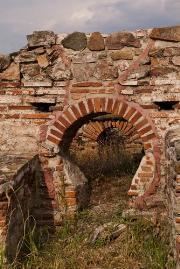Time zone EET (UTC+2) Elevation 129 m Area code 04712 | Postal Code 8629 Local time Friday 1:54 PM | |
 | ||
Weather 9°C, Wind N at 18 km/h, 43% Humidity | ||
Kabile (Bulgarian: Кабиле), Cabyle, or Kabyle is a village in southeastern Bulgaria, part of the Tundzha municipality, Yambol Province. The ruins of the ancient Thracian city of Kabyle can be found nearby, and it remained an important fortress throughout the Middle Ages.
Contents
Map of 8629 Kabile, Bulgaria
Geography
Kabile village is located 3 km northwest of Yambol. Zaychi vrah, the last hill of the Sredna Gora mountain range, can be found 1.5 km north of Kabile. The road from Yambol to the village of Zhelyu Voyvoda (in the Sliven Province) passes through Kabile, as well as the road from Yambol to the village of Drazhevo.
The name of the habitat originates from Cybele.
History
The site was inhabited since the 2nd millennium BC and traces of a Neolithic culture have been unearthed. Ceramics discovered from the 10th to the 6th century BC prove that the site was inhabited during the early Iron Age as well. In 341 BC the town was founded or refounded by Philip II of Macedon, who fortified it; subsequently, the town became a polis. It was under the rule of Philip II, Alexander the Great and Lysimachus from 341 BC up to 280 BC, when it came under the control of the Thracian Odrysian kingdom from 280 BC. However, its activities were diminished after the 2nd century BC due to aggressive campaigns by Philip V of Macedon. Later it fell under the control of King Cavarus of the Celtic Kingdom of Tylis. The city minted coins on behalf of the local Thracian leaders Spartokos (early 3rd century BC) and Sostokos, as well as the Celt Cavarus.
Kabile used to be one of the most important and largest towns in Thrace. Architectural remains are impressive, most of them preserved and restored.
Christianity became widespread in the area as early as the 4th century AD, and Kabile became an episcopal center. The town was finally destroyed in the 6th century AD by the Avars. In the 9th century, the surrounding region was fully integrated into the Bulgarian Empire, and a Bulgarian settlement was established over the ancient ruins, where the nearby town of Dubilin (Yambol) was built.
Other names for the village were Izvor ("spring"), after the nearby water spring. The name "Kabile" was reintroduced in the 1950s.
Economy
Most of Kabile's population works in Yambol. The economy is based on agriculture. There is also a factory for sweets.
Religion
The population is mostly Christian Orthodox. There are a few churches.
Social institutions
Honour
Kabile Island off Greenwich Island in the South Shetland Islands, Antarctica is named after Kabile.
